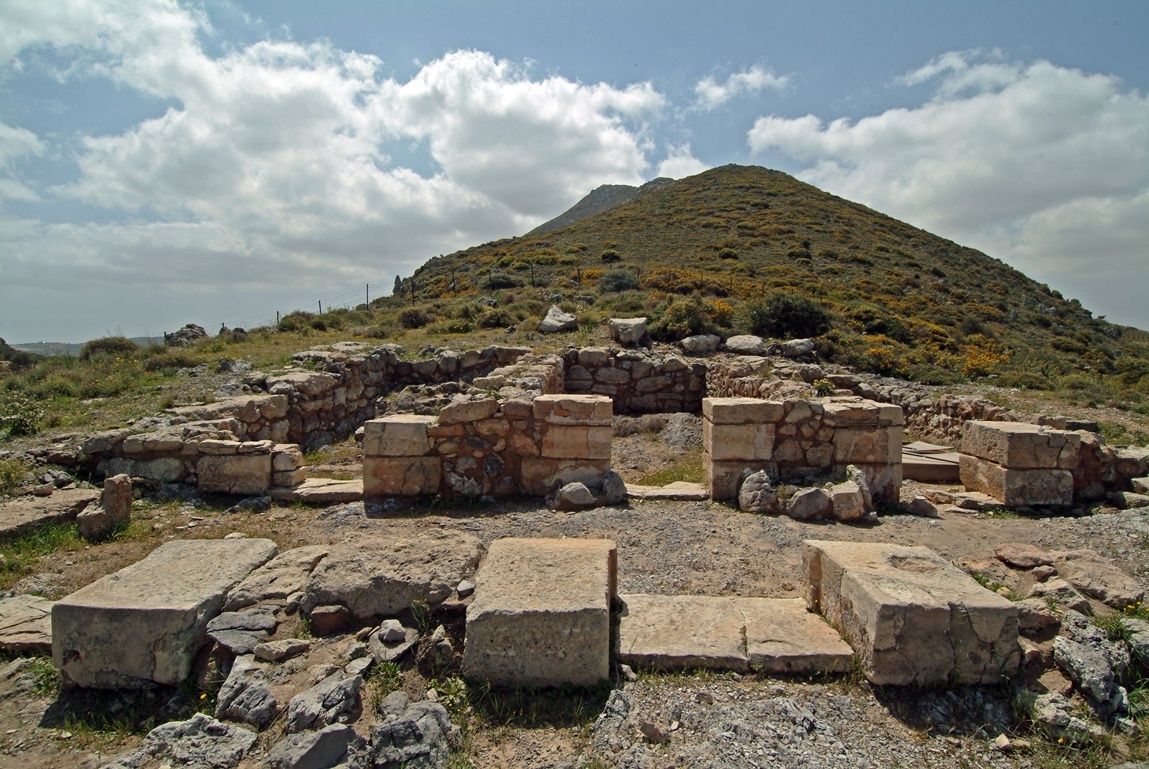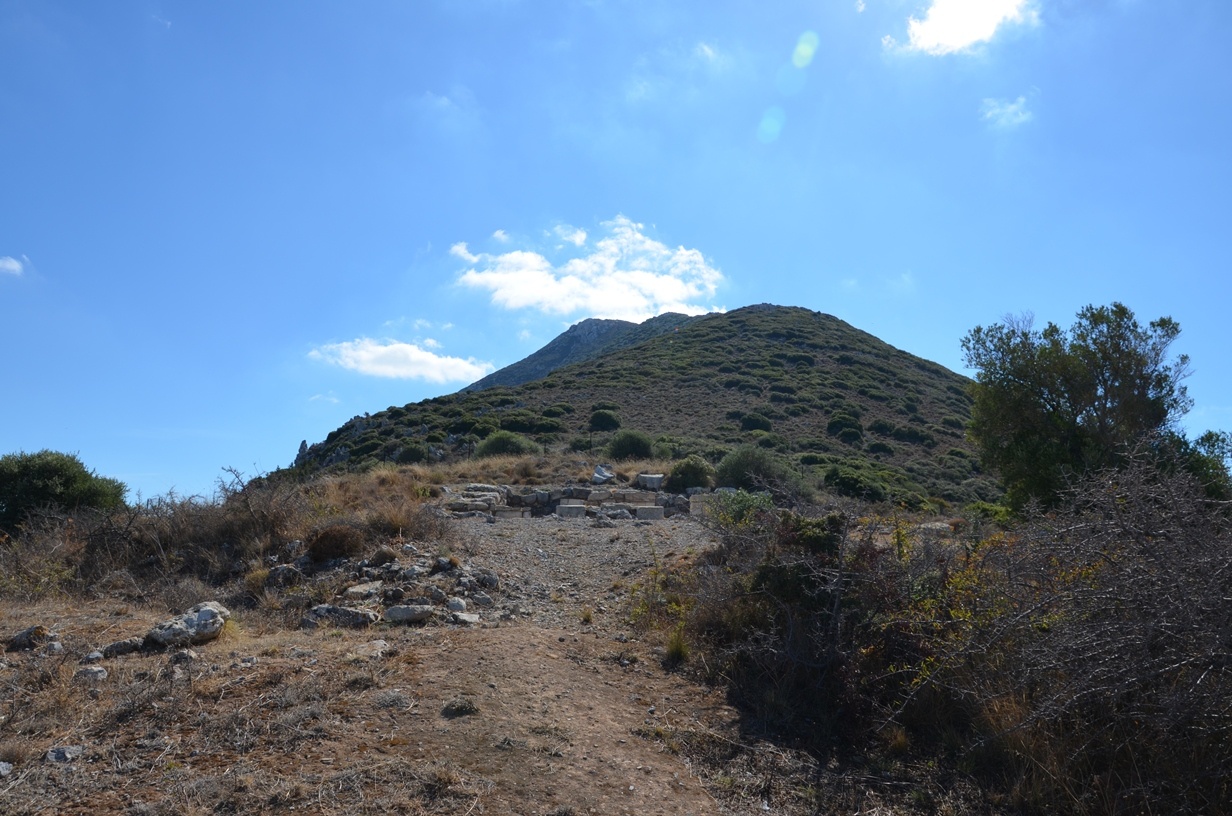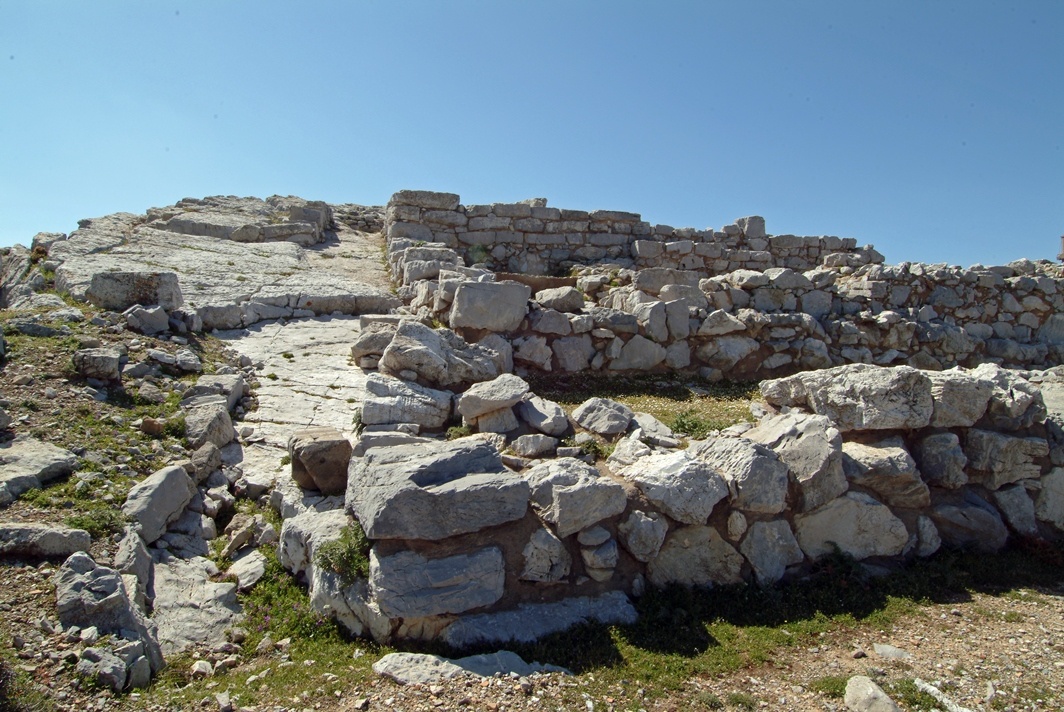
Nearest hamlet: Epano and Kato Archanes
Distance: 7.7km
Duration: 3 hours
Entrance coordinates: 35° 15.341'N / 25° 8.672'E (Anemospilia)
Exit coordinates: 35° 14.195'N / 25° 9.239'E (Epano Archanes - ring road)
Trail type: Well-trodden trail with markers
Difficulty: Moderate
Recommended season: Year-round
Amenities: In Epano Archanes
Turn right from the Archanes ring road at the sign for ‘Vasilies’. Be careful on the narrow uphill road with its many sudden turns, leading to the archaeological site of ‘Anemospilia’, where there is a small parking area. You cannot enter the fenced Anemospilia archaeological site unless you have made arrangements with the relevant archaeological service (Tel: 2810 752712 – Archaeological Collection of Archanes). The trail starting here will lead you to the peak of Mt. Juktas.
The trail follows the western slope of the anthropomorphic mountain. Shortly before the peak (approximately at the height of the telecoms antenna) you can make out the ruins of the Minoan Peak Sanctuary. Continue to the chapel of Afentis Christos [Master Christ] from where you can enjoy the panoramic view of the entire region of Heraklion. This is the starting point of the second trail, downhill all the way, following the eastern side of Mt. Juktas, which ends at the Archanes ring road (at the ‘Afentis Christos’ sign). Please note that you must have taken care of leaving a car at the finishing point, as the starting and finishing points are some distance from each other, and will take you more than an hour’s hike on asphalt to get from one to the other.
Download the kml file of the route in your device: (kml) Anemospilia – Mt. Juktas – Archanes
Anemospilia

The Anemospilia was an important landmark in the history of Archanes. There, on the north slope of Mt. Juktas, with views towards Dikti, Ida, and every other major or minor centre on the north coast, was where Yannis and Efi Sakellarakis, in 1979, found a unique –to date– temple from the Minoan Period. The Anemospilia building stood for only half a century. It was unexpectedly ruined by an earthquake in the mid-17th century BC. Entry to the enclosed archaeological area is not permitted without prior arrangement with the competent archaeological service (Tel.: 2810 752712).
The Building
On the site, archaeologists have excavated a four-room building, which might have featured additional auxiliary spaces. It is a solid structure, with thick walls covered in partially preserved white or red masonry. Cut tuff stone was used for the thresholds and frames.
The rectangular building comprises three closed rooms of equal size along the south and a long corridor in the north that covers the length of all three rooms. The building is surrounded by an enclosure, believed to have been a temple, the statue of the deity residing in the main chamber.
This type of building is known from works of art depicting tripartite temples, such as the gold flattened strips from Mycenae and Volos, the stone rhyton (liquid containing) vase from Zakros and the Archanes ring. These representations depict freestanding temples on mountain slopes, the types of which were later transferred to residential complexes, such as those of Vathypetro and Knossos palace.
According to researchers, the antechamber was where the preparations for acts or worship were made. The discovery of 150 vessels of various shapes, including an important chalice, as well as jars, pestles and pots has provided further evidence. The jars, some of which are carved with writing, were used at temples to store fabric but also the necessary liquid and solid foods for rituals. Both pestles and pots were used during preparations. The antechamber’s benches did not only function as seating but were also used to store vessels. In front of the double wooden door at the entrance to the central chamber stands a stone structure, possibly used for libations or cleansing rituals.
The central chamber was packed with the largest vessels in the temple. Besides the jars stored along the walls, the entire room was full of vessels with the exception of the north and northwest parts. This chamber was where an important discovery was made: a pair of unnaturally large ceramic feet with a finished hole on their upper surface. Around the feet a thick layer of wood ash was found, which hints at the object being a remnant of a large wooden acrolithic statue – a statue whose extremities were made of different material than its main body. This acrolithic technique was known in the Aegean since the Neolithic Period and on Crete since the Middle Minoan Period. According to the archaeologists, the statue would have been placed in the central chamber of the Archanes temple, next to the non-sculpted rock intentionally placed in the same room, representing ‘the sacred earth’. The vessels found all around are indicative of the offerings to the deity of worship following both bloody and bloodless rituals performed in separate areas. Charred nuts have been found in a vessel, typical of such practices. Perhaps the last offerings were made on the non-sculpted rock.
According to the evidence, bloodless rituals were carried out in the spacious eastern room, featuring a graded structure sculpted on the rock that probably served as an altar. Baskets, prochous (beaked) vases of various shapes and three calyx-shaped cups are some of the objects found in this room. The cause of the building’s destruction, a powerful earthquake that took place in the first half of the 17th century BC, offers a possible explanation for the findings in the western chamber of the temple.
Here, the skeletal remains of two humans were found, whose cause of death is related to the falling stones and wood panels from the room and the resulting fire. Moreover, the skeletal remains of a third person were found on a table like structure shaped like a pedestal rising from the plastered floor. This person’s death was from a wound inflicted using a sharp-edged weapon. This, according to archaeologists, was the result of human sacrifice – a rare but actual practice in Minoan Crete. Finally, a third body has been discovered, crushed while the person was trying to leave the building.
Mt. Juktas

Mt. Juktas Ecological-Archaeological Park is comprised by Knosano Gorge (Agia Eirini Gorge), Astrakiano Gorge and Kounaviano Gorge.
Mt. Juktas is a mountain formed exclusively of limestone. Its rocks are older than those of the broader region. It was formed a million years ago, during the Cretaceous period (145-68 million years ago), while around it lay sediments of the more recent Pliocene epoch (5.3-1.6 million years ago).
The Mt. Juktas part is 3km west of Archanes and 18km south of the city of Heraklion. It covers a total area of 4km2 and has a North-South longitudinal shape. Its highest peak is 811m high. The west slopes are steep with a gradient of up to 100%, while the east slopes are milder with a gradient of up to 50%. So far there are eleven known caves on Mt. Juktas, of which Chosto Nero and Spelios Stravomyti (Buried Water and Crooked Nose Cave) have been explored and partially mapped.
In the north-northeast part of the region there is a torrent bed with relatively rich bank vegetation and a small gorge.
The region is included in the European Nature Network (Natura) 2000 for "the conservation of natural habitats and of wild fauna and flora” and it is considered an Important Bird Area (IBA) of the European Union. It is also protected as an ‘Archaeological Site’ and as a ‘Landscape of Exceptional Natural Beauty’.
The Park is surrounded by extensive vineyards and olive groves. The impact of human activity on the natural environment of the area (logging, clearing, cultivation, fire) has drastically changed its profile, although nobody can definitely say what the territory used to be like before human intervention. The sparse oak trees scattered in the Archanes basin might be remnants of the once prevailing vegetation. In general, human intervention is less intense on Mt. Juktas, and vegetation, although different in the quantity and quality of flora composition than in the past, has maintained several of its original features. Around 360 different plant species have been identified, of which 18 are endemic to Crete and/or Greece. Wood stemmed bushes with small leaves that often have thorns prevail (underbrush), such as thymios (thyme), angarathia (Jerusalem sage), astoivida (Sarcopoterium spinosum), and chinopodi (type of fleawort). Locally there are deciduous, flat-leafed species, such as Kermes Oak and the carob tree, which in some places are small trees. Numerous herbs appear after the first rains and turn Mt. Juktas turns green by springtime. Several species grow on steep slopes, such as chasmophytes, which are unique and have not been affected by the human presence. Among them are dittany and the Cretan white ebenus (Ebenus cretica).
The fauna of Mt. Juktas has not been studied in depth, although it is truly interesting for various reasons, since there are species that complete their life cycle in this habitat, as well as others that visit the locality temporarily or use it as a nesting site.
The number of invertebrates comes to several hundreds, many of them endemic. Snails, millipedes, spiders, herbivorous, carnivorous and carrion-feeding insects can be found everywhere, even in the depths of caves. Amphibians have been sited mainly at the foot of the mountain and include the yellow bellied toad and the common tree frog. Reptiles are represented by a type of lizard (Lacerta trilineata) and two species of harmless snake, the ‘spitofido’ (house-snake, Zamenis situla), which is called ‘ochentra’ on Crete and it is not related to the adder, whose name is very similar in Greek, as well as ‘gatofido’ (cat snake, Telescopus fallax). There are a total of eight mammal species, three of which are insectivores (a bat, Hipposideros rhinolophus, a mole, the Cretan shrew, Crocidura zimmermanni, the hedgehog) and three rodents (the house mouse, Mus domesticus, the rock mouse, Apodemus mystacinus and the rat), a type of hare, three carnivores (the European badger, Meles-meles arcalus, the Cretan Beech Marten, Martes foina-bunites and the Cretan least weasel (Mustela nivalis galinthias).
Bird fauna of the island is particularly significant, as around forty bird species have been spotted and vulture reproduction here is of major importance. There are also other rare and/or endangered species, such as the falcons ‘petritis’ (Falco peregrinus) and ‘mavropetritis’ (Falco eleonorae).
Endemic Plants of Crete
Crete has the greatest plant biodiversity of all Mediterranean islands, with the exception of Sicily, which, however, is three times as large. Cretan flora comprises of around 1,800 plant species, of which 180 are endemic to Crete, i.e. they are not encountered anywhere else in the world.
The Botany Department of the Natural History Museum of Crete – University of Crete, in the effort to highlight Cretan flora and, in particular, the endemic and endangered plants of Crete, has established the first ‘arc’ of endemic plants on Mt. Juktas.
Anthropomorphic Mt. Juktas, the sacred Minoan mountain, with its numerous archaeological sites is a natural refuge of rich flora (380 plant species, of which 21 are endemic to Crete), rarely encountered elsewhere in Europe. All of the above makes it apparent that around 1/5 of Cretan flora and 1/11 of endemic Cretan flora grows on Mt. Juktas. This is why this territory has been included in the European Union list of CORINE BIOTOPES, the important biotopes to be conserved in Europe, while it is also included in the ΝAΤURA 2000 Network, under Code No: GR 4310002 “Mt. Juktas-Agia Eirini Gorge”.
Iero Korifis

One of the most important peak sanctuaries of Minoan Crete. It consists of four terraced benches, with an altar on the first, and six rooms looking to the east. The finds - votive dedications are of exceptional archaeological value.


